一、本期重点:
1.采用调制照明和桶检测的计算机重构图像的分辨率分析(Resolution analysis in computational imaging withpatterned illumination and bucket detection)[OPTICS LETTERS]
doi:10.1364/OL.39.003888
内容介绍:
D. Rodríguez等在文中展示了空间结构光调制照明的重构图像的光学分辨率仅受投影光学系统的NA影响,不受图像采集系统的光学元件影响。并给出了对比实验,证明在光学成像方面,单像素探测器的分辨率优于普通的CCD阵列。这一结论在考虑了实际情况下的光学像差,样品和探测器的光学缺陷给出,并且提供了验证性实验。
实验中采用的系统原理图如图1所示。光学系统分为两部分:照明系统和采集系统,分别位于物体OB的左右两侧。在照明系统中,SLM提供光强的二元调制。这些光通过光学透镜和显微物镜投影在物体上。在采集系统中,低数值孔径的显微物镜用于收集透过物体的光,PMT对光进行积分。最后通过采用优化算法,重构物体的图像。为了比较单像素系统和普通系统的光学分辨率,在BS2后放置了一个CCD。
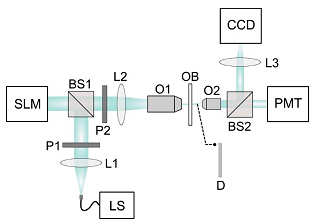
Fig. 1. Experimental setup for image resolution analysis viaHadamard illumination using a single-pixel architecture. Seetext for details
实验结果如图2所示。实验结果表明,计算机重构的图像包含有普通光学系统限制的频率,即,单像素系统能够提供超出瑞利判据的分辨率。
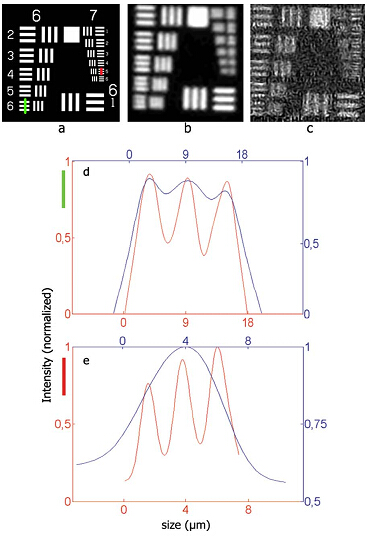
Fig. 2. Experimental results for image resolution analysis. (a)Part of the USAF test image. (b) Image obtained with CCD camera. (c) Reconstructed image of128×128pixels via single-pixelimaging (CR =2). Panels (d) and (e) show intensity profiles forUSAF elements 6-6 and 7-5, respectively. Blue lines correspondto the CCD camera and red lines to the single-pixel image. The curves have been smoothed.
为了说明系统的分辨率不依赖于收集系统,对光学像差也不敏感,接着,文章证明了系统能够在加了光学散射版后重构出物体。如图3所示,可以看到,普通光学系统收集到的图像已经模糊,而根据单像素探测器收集到的信号还能够重构出图像。
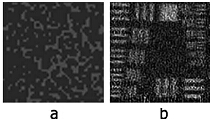
Fig. 3. Images taken through a commercial diffuser placedbetween OB and O2 (see Fig.1). (a) Image obtained withCCD camera. (b) Reconstructed image via single-pixel imaging(CR=2).
2.基于曲面微透镜的多通道结构宽角度相机(Wide-angle camera with multichannel architectureusing microlenses on a curved surface)[APPLIED OPTICS]
doi: 10.1364/AO.53.003696
内容介绍:
台湾大学的Wei-Lun Liang等人提出了多通道的光学成像系统将昆虫的复眼和人类眼睛结合起来。光学系统减少成像的光程,使得系统小型化。通过弯曲的微透镜阵列形成多通道的结构,对称弯月镜用来作为主透镜仿真人眼,获得大的FOV。阵列中每一个微透镜传输整个视场的一部分。通过图像处理的技术,将每个通道得到的图像拼接起来,获取最终的全视场图像。
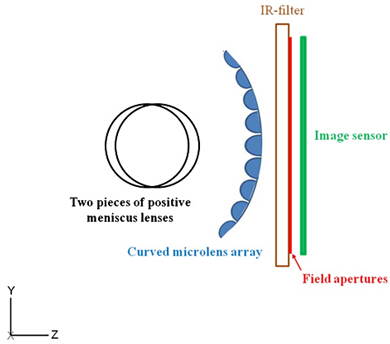
Fig. 1. Schematic diagram of the multichannel imaging systemprototype illustrating the structure of the optical module, whichis directly attached to an image sensor (shown in green).Microlenses are indicated in blue; two pieces of meniscus lenses arein black; IR filter is in brown; and field apertures are in red.
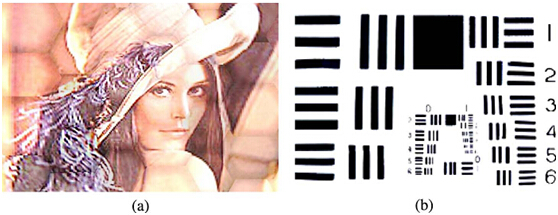
Fig. 16. Stitching every partial image to recombine the full image and adjust brightness. (a) Image of“Lenna”. (b) Image of“1951 USAFchart”
二、简讯:
published:2014.06.09
This Letter presents a theory that allows graded index lenses to be mapped onto arbitrary rotationally symmetriccurved surfaces. Examples of the Luneburg and Maxwell fish-eye lens are given, for numerous surfaces, alwaysresulting in isotropic permittivity requirements. The performance of these lenses is initially illustrated withfull-wave simulations utilizing a waveguide structure. A transformation of the refractive index profiles is thenperformed to design surface-wave lenses, where the dielectric layer is not only isotropic but also homogenous,demonstrating the applicability and ease of fabrication.
doi:10.1016/j.optcom.2014.05.065
published:2014.11.15
Abstract
An optical processor for synthetic-aperture imaging ladar (SAIL) utilizing one astigmatic lens is proposed. The processor comprises two structures of transmitting and reflecting. The imaging process is mathematically analyzed using the unified data-collection equation of side-looking and down-looking SAILs. Results show that the astigmatic lens can be replaced with a cylindrical lens on certain conditions. To verify this concept, laboratory experiment is conducted, the imaging result of data collected from one SAIL demonstrator is given.
published:2014.06.19
Abstract:
We study light scattering by cylindrical multilayer structures containing Kerr-type nonlinear materials. We develop a new semi-analytical method for solving such nonlinear problems by reducing the original 2D system by a 1D nonlinear Helmholtz equation. We apply our method for the case of wave scattering by the core-shell metal-dielectric nanowire and show that the nonlinearity allows us to control scattering cross section, which in the resonant regime demonstrates optical bistability. We compare our method with the finite-difference time-domain (FDTD) approach and find that the new approach is accurate and is 105 times faster and more numerically robust than the FDTD.
供稿:李璐







